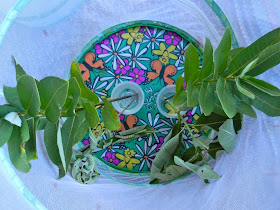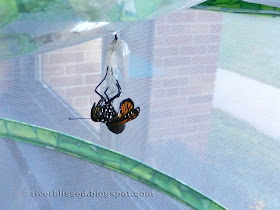Despite the moon not making an appearance, something rather special happened today when the harvest moon was at 100% fullness: My very last monarch butterfly was born. I found her when she was a tiny caterpillar barely 1/4" long and watched her munch milkweed leaves for about two weeks before becoming a chrysalis. My students and I kept a close watch as the chrysalis changed, gradually becoming more transparent.
For the past two days, I kept the chrysalis (in a tent) by my side constantly, not wanting to miss the birth. I brought him home with me, placed him in the front seat of the car while I chauffeured my children to and fro, and even kept him next to my bed at night. I was convinced he was going to emerge yesterday and at bedtime had my fingers crossed that he wouldn't accomplish this great feat while I was sleeping. I was thrilled to wake up in the morning and see he was still a chrysalis.
The saying about waiting for water to boil also applies to waiting for a butterfly to be born! I carried him from room to room with me and then finally decided to focus on lesson plans for the upcoming week.
A butterfly's birth is a silent event, and when I looked up from the computer, he was a crumpled-winged butterfly, probably a couple minutes old.
There is an old wives' tale (apparently unsupported by statistics) about more babies being born during the full moon. Whereas I never experienced this myself, I'm nonetheless surprised it never occurred to me during the two days of chrysalis toting that the full moon would be the perfect time for this butterfly to be born! I named him Harvest.
I continued to observe Harvest throughout the day, and when the temperature was warm enough, I brought him outside and introduced him to a marigold.
However, Harvest didn't leave the flower and was still there as the temperature dropped, so I brought him back inside and put some flowers in the butterfly tent. I'll try again tomorrow to get him outside when the temperature is warm enough for him to fly. I could care for a butterfly for several days in the butterfly tent, but Harvest really needs to get on his way. And he seems to know this. Disinterested in the flowers, he spends time at the top of the tent, appearing as if he wants out.
Harvest has a great journey ahead of him, and it's getting late in the season. He is part of the fourth generation of monarch butterflies this year and has a longer potential lifespan that those of the previous three generations (who only live for two to six weeks). The generation of monarch butterflies born in the fall migrates to a warmer climate and may live up to nearly nine months, clustering on special trees that keep them warm throughout the winter. (When I read about or see images of the monarch butterfly trees in Mexico, the sacred tree in the movie, Avatar, comes to mind.) Yet, cool weather is only one threat to the monarch butterfly's survival. Rainstorms and predators are also dangers along the way.
It takes four generations of monarch butterflies to complete the 4,000 mile round trip from the northeastern United States and southern Canada to Mexico and back. Harvest's generation makes the trip, having never made a long journey before - and yet, each year the fourth generation of monarch butterflies somehow finds its way to the very same overwintering destination as its predecessors the year before. Born alone without parents to guide them, they are following something. Their inner navigational system knows what to do. Wow.
In addition to the dangers they face while migrating, there are also beneficent forces at play. The migrating monarchs are able to give their tiny wings a break by soaring on thermals. They have a keen sense of direction and also know to stop when conditions are not favorable and wait it out until winds have shifted in their favor. Of course, I perceive all this as one big, incredible metaphor for the human potential to awaken to and follow our own internal guidance systems!
I have observed Harvest's life cycle for the past 26 days and have grown attached to him. I want him to make it to one of the monarch butterfly tree colonies down south, somehow experiencing the victory of a successful journey and being all he can be - fulfilling his potential and helping his species to continue. However, knowing what is best for him, I will need to let Harvest go tomorrow.
When I put Harvest up to a flower today and let him creep down my fingers to the colorful petals, it reminded me of the letting go involved with my oldest child beginning college and being a newly licensed driver this semester. That was the metaphor that was alive for me today.
It is not enough to wish the world will be kind to my daughter and this newborn butterfly. I remember when my daughter went through a prolonged Wizard of Oz stage when she was little. How many pairs of glittery ruby slippers must I have bought for her as she kept growing out of them and wearing them out? How wonderful it would be to have magical shoes that can protect you from all the dangers along the way! I always wanted a pair for myself when I was a child. Visualizing my daughter surrounded with protective white light is the practice that seems to come closest - and until my children were about ten years old, I did a white light visualization with them every evening at bedtime. However, the other part of the equation is wishing that she (and Harvest) will develop strong wings and a strong inner guidance system to carry her through life's storms. These are a mother's prayers.
Harvest is struggling with cooler fall temperatures just as my daughter struggles with coordinating transportation and balancing the demands of two part-time jobs and full-time coursework. It seems both my daughter and the butterfly will need the endurance of an Olympic athlete to succeed in their journeys, and I can only do so much at this point. It is their time to fly, and I need to stand here and watch them try out their wings for the first time and hope they will discover, trust, and follow that little voice that knows the way.
* * * * * * * *





















































